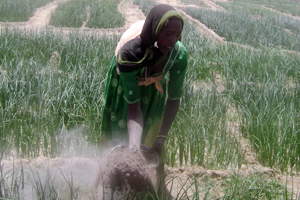
Women do the farming in Chad and put food on the family table.
Credits: Adoum Goulgué/SECADEV
Granite hills mark the horizon. The ground is carpeted with rocks. Apart from the dried up river beds (ouaddis) there is nowhere for vegetation to grow. Thorny shrubs are the only desert plant life. Nature is hostile in Eastern Chad.
“Annual rainfall normally varies from 300 to 500 mm,” said Adoumadji, an agricultural technician working for SECADEV (Caritas Chad). “Less than 300 mm of rain fell last season. Crops dried up before they could yield anything.”
Yassine Ibrahim harvested less than four sacks of millet this season, compared to previous years when he produced 23 sacks. “The little harvest I have got is finished and I am obliged to sell my cattle to feed my family,”he said.
Extra demand means prices for cereals have risen so high they are unaffordable for most people. SECADEV supports community granaries in twenty villages. Residents share the food when prices are peaking, then top up the granaries from the next harvest.
Farmers are encouraged to diversify into other crops. Growing beet, carrot, tomato and turnip provides a more balanced healthy diet and an extra income. “The money I earn from selling my garlic and onions allows me to feed my children,” said Achat Abderahim, a mother of two.
